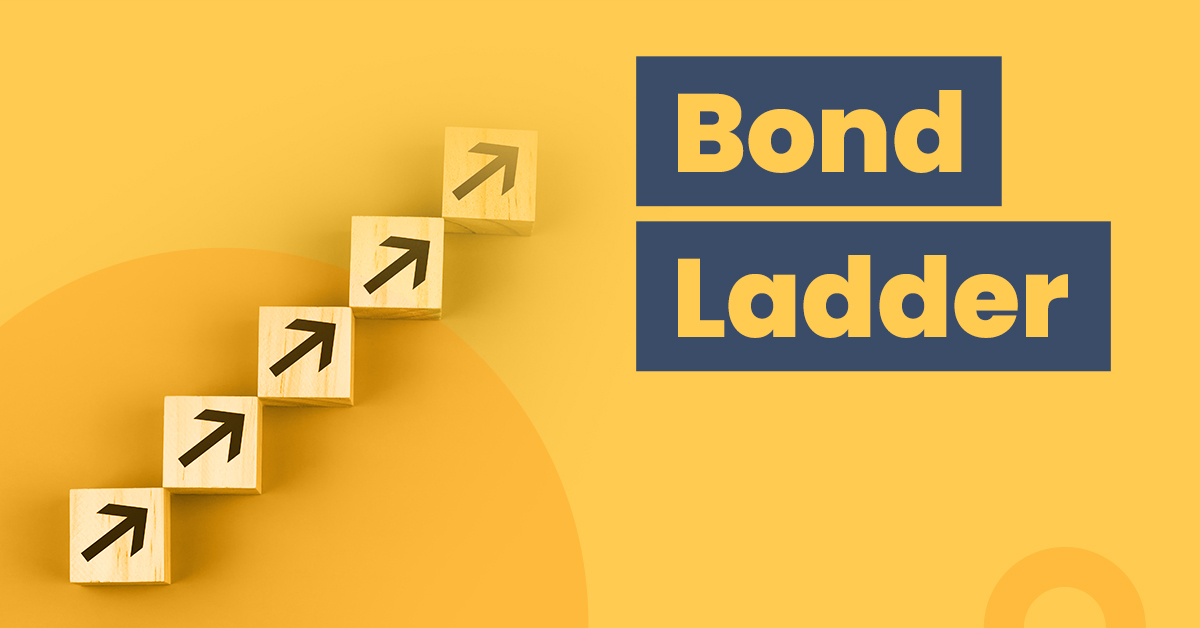Bond Ladder: Meaning, Objectives, Benefits & Risks


Bonds are a very popular instrument of investment. There are varying investment strategies that you can opt for to maximise the returns from bond investments. For example, you can invest a large amount in one bond, whereas you can invest smaller amounts in many bonds simultaneously.
A bond ladder is one such investment strategy in which you will build a bond portfolio, each having different maturity dates at equal intervals. The equal spacing of maturity dates will allow you to redeem the bonds and reinvest their proceeds at regular intervals.
Let’s see various working aspects of this investment strategy and how it can help you in building a profitable portfolio.
What Is a Bond Ladder?
This investment strategy involves purchasing several bonds of smaller amounts, each having a different maturity date, i.e., maturity dates are evenly spaced out with each other. This strategy will help you mitigate different risks associated with bonds, like interest rate risks, credit risks and liquidity risks.
After receiving the redemption proceeds from one bond, you can reinvest the proceeds into a different bond. This way, you will be able to maintain a hold over various bonds at equal intervals. The reinvestment occurs in a bond which has a maturity period equivalent to the longest tenure in the ladder strategy.
Now, if market interest rates increase, you can book higher yields by putting your money in high-yielding bonds. On the other hand, if interest rates fall, you can hold bonds that have a higher yield.
Now that you are well versed with the basic definition of the bond ladder, let’s move to its other aspects like working and objectives.
What Is the Objective of Bond Laddering?
The bond ladder investment objective fulfils the following objectives:
- Have a steady stream of income in the form of interest payments evenly spread out across the year.
- To reduce the interest rate risk by not investing all the money in a single coupon rate. Furthermore, it reduces the reinvestment risk which would occur if you had opted for the rollover of all matured bonds at the same time.
How Does a Bond Ladder Function?
Primarily, the investment strategy of bond laddering deals with creating a large basket containing several fixed-income instruments. You can use corporate bonds, municipal bonds, treasury bills, certificates of deposit, etc., to formulate the strategy.
It uses various instruments to serve its goals. There are several things that you should consider while creating a bond ladder. It involves the amount to be invested, the maturity period of each bond, and the spacing between each fixed-income instrument. If you are seeking higher liquidity, you should keep the spaces short.
Suppose you have a corpus set aside for investment amounting to ₹5 lakh. You want to invest in 5 bonds over a span of 5 years with all securities spaced 1 year apart. When the first-year bonds mature, you can reinvest their proceeds into a bond having a maturity of five years. Similarly, when the second-year bond expires, you can reinvest the proceeds in 5-year bonds.
This cycle will continue each year till you have bonds of 5-year maturity evenly spaced out one year apart. As bonds expire, proceeds will be rolled over, and this process can go on till perpetuity.
What Are the Advantages of Using the Bond Ladder Strategy?
Here are some advantages of the bond ladder strategy:
- Liquidity
Laddering will allow you to earn a fixed income with higher yields. Instead of locking in your funds for a long term in debt instruments, bond laddering will always lead to a certain amount of liquidity, as some of the bonds will keep on maturing at regular intervals.
- Lowers risk
One of the main reasons that individuals opt for this investment strategy is that it reduces interest rate risk. Bonds having a longer maturity or expiry date are vulnerable to changes occurring in the interest rate. As this strategy always has one or the other bonds maturing, you can use the proceeds to reinvest into new fixed-income instruments at a higher market interest rate.
- Diversification
Another benefit of this strategy is the diversification of the investment basket that it leads to. You are free to incorporate different kinds of fixed-income debt instruments. Some will come with higher risk than others, and it will help to maintain stability of the overall portfolio.
Furthermore, some bonds will be high yielding while some will come with lower yields, and as a result, there will be a steady flow of income.
What Are the Cons of Using a Bond Ladder?
Here are some cons or disadvantages of using a bond ladder:
- In case the interest rates fall at the time of bond expiration, you will have to roll in newer bonds at low-interest rates. This will hit or reduce your earnings.
- If you need immediate funds to overcome a financial emergency, you will have to sell some bonds, and if you exit when the interest rate is rising, you will lose out on the earnings.
- This strategy comes with multiple transactions, there might be certain charges attached to it which will reduce your net earnings. So check if there are any charges or not
Final Word
Bond ladder is a unique investment strategy that comes with rolling over bonds at equal spaced-out intervals. It has several benefits, such as risk reduction as well as enhanced liquidity. But it also comes with some drawbacks. Therefore, it is important that you consider cost-benefit analysis before taking any decision regarding the investment.
Frequently Asked Questions
What can be an alternative to the bond ladder?
Liquid ETFs or Exchange Traded Funds that invest in fixed income instruments can be an ideal replacement for the bond ladder. They come with a diversified investment portfolio having bonds and other fixed-income instruments of different maturities. That being said, the charges and service fees on these ETFs might be higher.
Can I build a bond ladder with callable bonds?
No, callable bonds are not an ideal option for the bond laddering strategy as it gives an option to bond issuers to buy the bonds back before maturity. Therefore, it may not lead to equal interval maturities.
How long should the bond ladder be?
The length of bond ladders varies from one individual to another. You can consider your investment goals and horizon and take a decision regarding the number of ladders that you wish to create.
What are the different components of a bond ladder?
There are three components of a bond ladder, namely – rungs which represent investment amount, height which indicates the spacing and materials which exhibit the nature of the portfolio.



